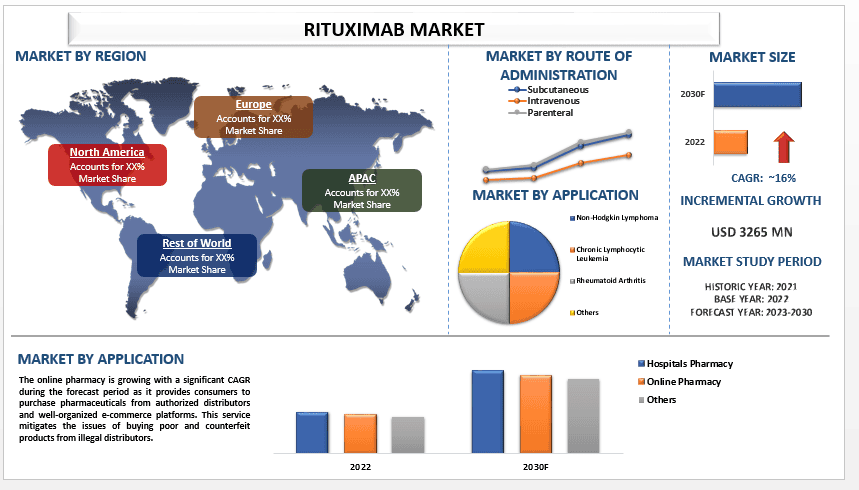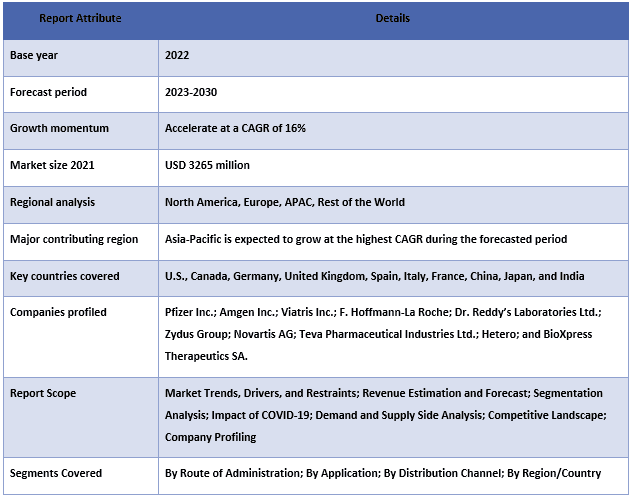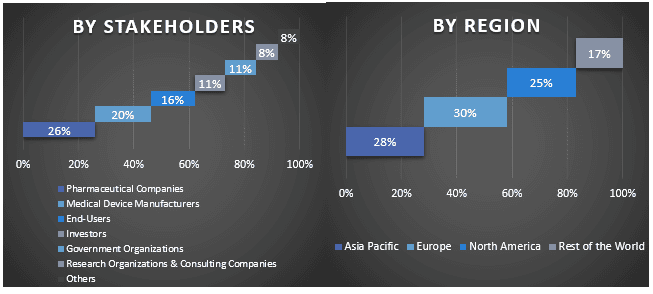- Trang chủ
- Về chúng tôi
- Ngành
- Dịch vụ
- Đọc
- Liên hệ với chúng tôi
Thị trường Rituximab: Phân tích hiện tại và Dự báo (2022-2030)
Nhấn mạnh vào Đường dùng (Dưới da, Tiêm tĩnh mạch và Đường tiêm); Ứng dụng (U lympho không Hodgkin, Bệnh bạch cầu lymphocytic mãn tính, Viêm khớp dạng thấp và Các bệnh khác); Kênh phân phối (Nhà thuốc bệnh viện, Nhà thuốc trực tuyến và Các kênh khác); và Khu vực/Quốc gia.

Thị trường Rituximab được định giá 3265 triệu USD và dự kiến sẽ tăng trưởng với tốc độ CAGR mạnh mẽ khoảng 16% trong giai đoạn dự báo (2023-2030). Thị trường đang phát triển nhờ sự gia tăng số lượng sinh phẩm tương tự có sẵn trên thị trường. Sinh phẩm tương tự là các phiên bản thuốc gốc của các chế phẩm sinh học đã hết hạn bằng sáng chế. Hiện tại, một loạt các sinh phẩm tương tự cho Rituxan đã được các cơ quan quản lý phê duyệt và đã cho thấy sự chấp nhận đầy hứa hẹn của bệnh nhân do hiệu quả chi phí của chúng so với các loại thuốc mang nhãn hiệu. Bên cạnh đó, một số sinh phẩm tương tự cũng đang trong các thử nghiệm lâm sàng, dự kiến sẽ gia nhập thị trường trong những năm tới. Ví dụ: vào tháng 1 năm 2023, Dr Reddy's Laboratories thông báo rằng họ đã hoàn thành thành công toàn bộ các nghiên cứu lâm sàng về ứng cử viên sinh phẩm tương tự rituximab được đề xuất, 'DRL_RI' để nộp hồ sơ tại các thị trường được quản lý chặt chẽ như Hoa Kỳ, Châu Âu và các khu vực khác.
Một số công ty lớn đang hoạt động trong lĩnh vực này bao gồm Pfizer Inc.; Amgen Inc.; Viatris Inc.; F. Hoffmann-La Roche; Dr. Reddy’s Laboratories Ltd.; Zydus Group; Novartis AG; Teva Pharmaceutical Industries Ltd.; Hetero; và BioXpress Therapeutics SA. Một số hoạt động M&A cùng với quan hệ đối tác đã được các công ty này thực hiện để tạo điều kiện cho khách hàng tiếp cận các sản phẩm/công nghệ tiên tiến và sáng tạo.
Thông tin chi tiết được trình bày trong Báo cáo
“Trong số các đường dùng thuốc, phân khúc đường tiêm sẽ tăng trưởng với CAGR cao trong giai đoạn dự báo”
Dựa trên đường dùng thuốc, thị trường được phân khúc thành tiêm dưới da, tiêm tĩnh mạch và tiêm. Danh mục đường tiêm được dự đoán sẽ tăng trưởng với CAGR đáng kể trong giai đoạn dự báo vì rituximab đường tiêm được thiết kế để tồn tại trong cơ thể lâu hơn, có khả năng cung cấp phương pháp điều trị kéo dài hơn. Hơn nữa, rituximab đường tiêm có thể được bảo quản ở nhiệt độ phòng, giúp dễ dàng vận chuyển và sử dụng ở những khu vực xa xôi hoặc thiếu nguồn lực.
“Trong số các ứng dụng, danh mục viêm khớp dạng thấp chiếm thị phần đáng kể trên thị trường vào năm 2022”
Theo ứng dụng, thị trường được phân loại thành u lympho không Hodgkin, bệnh bạch cầu lymphocytic mãn tính, viêm khớp dạng thấp và các bệnh khác. Viêm khớp dạng thấp chiếm thị phần đáng kể trên thị trường vào năm 2022, do sự gia tăng tỷ lệ mắc bệnh viêm khớp dạng thấp trên toàn cầu. Hơn nữa, số lượng nghiên cứu ngày càng tăng về việc sử dụng rituximab trong điều trị RA cũng tác động tích cực đến sự tăng trưởng của thị trường. Ví dụ: trong một nghiên cứu thực tế, bệnh nhân bị viêm khớp dạng thấp (RA), những người mới bắt đầu điều trị bằng rituximab hoặc chuyển đổi từ một nhãn hiệu thuốc khác đã có kết quả điều trị tích cực và tỷ lệ duy trì cao với sinh phẩm tương tự, GP2013 (Rixathon; Sandoz).
Phạm vi Báo cáo Thị trường Rituximab

“Trong số các kênh phân phối, nhà thuốc trực tuyến sẽ tăng trưởng với CAGR cao trong giai đoạn dự báo”
Dựa trên kênh phân phối, thị trường được phân khúc thành nhà thuốc bệnh viện, nhà thuốc trực tuyến và các kênh khác. Nhà thuốc trực tuyến đang tăng trưởng với CAGR đáng kể trong giai đoạn dự báo vì nó cho phép người tiêu dùng mua dược phẩm từ các nhà phân phối được ủy quyền và các nền tảng thương mại điện tử được tổ chức tốt. Dịch vụ này giảm thiểu các vấn đề mua các sản phẩm kém chất lượng và hàng giả từ các nhà phân phối bất hợp pháp. Hơn nữa, việc tăng cường thâm nhập internet of things và nâng cao nhận thức của các cá nhân cũng đang thúc đẩy sự tăng trưởng của phân khúc này trong những năm tới.
“Châu Á Thái Bình Dương sẽ tăng trưởng với CAGR cao trong giai đoạn dự báo”
Châu Á Thái Bình Dương được dự đoán sẽ tăng trưởng nhanh chóng trong những năm tới do sự gia tăng tỷ lệ mắc u lympho không Hodgkin và phản ứng khuyến khích của rituximab trong việc điều trị bệnh này. Ví dụ: theo WHO, khoảng 33.000 trường hợp NHL đã được chẩn đoán ở Nhật Bản vào năm 2020. Hơn nữa, các công ty trong nước đang tích cực đầu tư vào việc phát triển các sinh phẩm tương tự rituximab, do đó thúc đẩy sự tăng trưởng của thị trường. Ví dụ: vào tháng 1 năm 2023, Dr. Reddy’s thông báo đã hoàn thành các nghiên cứu lâm sàng về ứng cử viên sinh phẩm tương tự rituximab, dự kiến sẽ được phê duyệt trong những năm tới.
Lý do nên mua báo cáo này:
- Nghiên cứu bao gồm phân tích quy mô thị trường và dự báo được xác thực bởi các chuyên gia hàng đầu trong ngành đã được xác thực.
- Báo cáo trình bày một đánh giá nhanh về hiệu quả hoạt động chung của ngành trong nháy mắt.
- Báo cáo bao gồm một phân tích chuyên sâu về các đối thủ cạnh tranh nổi bật trong ngành, tập trung chủ yếu vào tình hình tài chính kinh doanh chính, danh mục sản phẩm, chiến lược mở rộng và những phát triển gần đây.
- Xem xét chi tiết các yếu tố thúc đẩy, hạn chế, xu hướng chính và cơ hội hiện có trong ngành.
- Nghiên cứu bao gồm toàn diện thị trường trên các phân khúc khác nhau.
- Phân tích sâu ở cấp độ khu vực của ngành.
Tùy chọn Tùy chỉnh:
Thị trường Rituximab toàn cầu có thể được tùy chỉnh thêm theo yêu cầu hoặc bất kỳ phân khúc thị trường nào khác. Bên cạnh đó, UMI hiểu rằng bạn có thể có nhu cầu kinh doanh riêng, vì vậy hãy thoải mái liên hệ với chúng tôi để nhận được báo cáo hoàn toàn phù hợp với yêu cầu của bạn.
Mục lục
Phương Pháp Nghiên Cứu Phân Tích Thị Trường Rituximab (2022-2030)
Phân tích thị trường trong quá khứ, ước tính thị trường hiện tại và dự báo thị trường tương lai của thị trường rituximab toàn cầu là ba bước chính được thực hiện để tạo và phân tích việc áp dụng rituximab ở các khu vực lớn trên toàn cầu. Nghiên cứu thứ cấp kỹ lưỡng đã được thực hiện để thu thập số liệu thị trường trong quá khứ và ước tính quy mô thị trường hiện tại. Thứ hai, để xác thực những thông tin chi tiết này, nhiều phát hiện và giả định đã được xem xét. Hơn nữa, các cuộc phỏng vấn sơ cấp kỹ lưỡng cũng được thực hiện với các chuyên gia trong ngành trên toàn chuỗi giá trị của thị trường rituximab toàn cầu. Sau khi giả định và xác thực số liệu thị trường thông qua các cuộc phỏng vấn sơ cấp, chúng tôi đã sử dụng phương pháp từ trên xuống/từ dưới lên để dự báo quy mô thị trường hoàn chỉnh. Sau đó, các phương pháp phân chia thị trường và phân tích dữ liệu tam giác đã được áp dụng để ước tính và phân tích quy mô thị trường của các phân khúc và phân nhóm của ngành liên quan đến. Phương pháp chi tiết được giải thích dưới đây:
Phân Tích Quy Mô Thị Trường Trong Quá Khứ
Bước 1: Nghiên Cứu Chuyên Sâu về Các Nguồn Thứ Cấp:
Nghiên cứu thứ cấp chi tiết đã được thực hiện để thu thập quy mô thị trường trong quá khứ của thị trường Rituximab thông qua các nguồn nội bộ của công ty như báo cáo thường niên & báo cáo tài chính, các bài thuyết trình về hiệu suất, thông cáo báo chí, v.v. và các nguồn bên ngoài bao gồm tạp chí, tin tức & bài viết, ấn phẩm của chính phủ, ấn phẩm của đối thủ cạnh tranh, báo cáo ngành, cơ sở dữ liệu của bên thứ ba và các ấn phẩm đáng tin cậy khác.
Bước 2: Phân Khúc Thị Trường:
Sau khi thu thập quy mô thị trường trong quá khứ của thị trường rituximab, chúng tôi đã tiến hành phân tích thứ cấp chi tiết để thu thập thông tin chi tiết và chia sẻ thị trường trong quá khứ cho các phân khúc & phân nhóm khác nhau cho các khu vực chính. Các phân khúc chính được bao gồm trong báo cáo là đường dùng, ứng dụng và kênh phân phối. Các phân tích cấp quốc gia sâu hơn đã được thực hiện để đánh giá việc áp dụng tổng thể các mô hình thử nghiệm trong khu vực đó.
Bước 3: Phân Tích Yếu Tố:
Sau khi thu thập quy mô thị trường trong quá khứ của các phân khúc và phân nhóm khác nhau, chúng tôi đã tiến hành phân tích yếu tố chi tiết để ước tính quy mô thị trường hiện tại của thị trường rituximab. Hơn nữa, chúng tôi đã tiến hành phân tích yếu tố sử dụng các biến phụ thuộc và độc lập như đường dùng, ứng dụng và kênh phân phối của thị trường rituximab. Một phân tích kỹ lưỡng đã được thực hiện cho các kịch bản phía cung và phía cầu xem xét các quan hệ đối tác hàng đầu, sáp nhập và mua lại, mở rộng kinh doanh và ra mắt sản phẩm trong lĩnh vực thị trường rituximab trên toàn cầu.
Ước Tính & Dự Báo Quy Mô Thị Trường Hiện Tại
Định cỡ Thị Trường Hiện Tại: Dựa trên những thông tin chi tiết có thể hành động từ 3 bước trên, chúng tôi đã đi đến quy mô thị trường hiện tại, những người chơi chính trong thị trường rituximab toàn cầu và thị phần của các phân khúc. Tất cả các tỷ lệ phần trăm được yêu cầu chia nhỏ và phân tích thị trường đã được xác định bằng cách sử dụng phương pháp thứ cấp được đề cập ở trên và được xác minh thông qua các cuộc phỏng vấn sơ cấp.
Ước tính & Dự báo: Đối với việc ước tính và dự báo thị trường, trọng số đã được gán cho các yếu tố khác nhau bao gồm các động lực & xu hướng, hạn chế và cơ hội có sẵn cho các bên liên quan. Sau khi phân tích các yếu tố này, các kỹ thuật dự báo có liên quan, tức là phương pháp từ trên xuống/từ dưới lên đã được áp dụng để đưa ra dự báo thị trường cho năm 2030 cho các phân khúc và phân nhóm khác nhau trên các thị trường lớn trên toàn cầu. Phương pháp nghiên cứu được áp dụng để ước tính quy mô thị trường bao gồm:
- Quy mô thị trường của ngành, về doanh thu (USD) và tỷ lệ chấp nhận của thị trường Rituximab trên các thị trường lớn trong nước
- Tất cả các tỷ lệ phần trăm, chia nhỏ và phân tích các phân khúc và phân nhóm thị trường
- Những người chơi chính trong thị trường rituximab toàn cầu về các sản phẩm được cung cấp. Ngoài ra, các chiến lược tăng trưởng được các công ty này áp dụng để cạnh tranh trong thị trường đang phát triển nhanh chóng
Xác Thực Quy Mô Thị Trường và Thị Phần
Nghiên cứu Sơ cấp: Các cuộc phỏng vấn chuyên sâu đã được thực hiện với những Người có Tầm ảnh hưởng Chủ chốt (KOLs) bao gồm các Giám đốc Điều hành Cấp cao (CXO/VPs, Trưởng phòng Kinh doanh, Trưởng phòng Tiếp thị, Trưởng phòng Vận hành, Trưởng phòng Khu vực, Trưởng phòng Quốc gia, v.v.) trên khắp các khu vực lớn. Các phát hiện nghiên cứu sơ cấp sau đó đã được tóm tắt và phân tích thống kê đã được thực hiện để chứng minh giả thuyết đã nêu. Thông tin đầu vào từ nghiên cứu sơ cấp đã được hợp nhất với các phát hiện thứ cấp, do đó biến thông tin thành những thông tin chi tiết có thể hành động.
Phân chia Người tham gia Sơ cấp ở các Khu vực Khác nhau

Kỹ Thuật Thị Trường
Kỹ thuật phân tích dữ liệu tam giác đã được sử dụng để hoàn thành việc ước tính thị trường tổng thể và để đưa ra các số liệu thống kê chính xác cho từng phân khúc và phân nhóm của thị trường rituximab toàn cầu. dữ liệu đã được chia thành một số phân khúc & phân nhóm sau khi nghiên cứu các thông số và xu hướng khác nhau trong các lĩnh vực đường dùng, ứng dụng và kênh phân phối trong thị trường rituximab toàn cầu.
Mục tiêu chính của Nghiên cứu Thị Trường Rituximab Toàn Cầu
Các xu hướng thị trường hiện tại & tương lai của thị trường Rituximab toàn cầu đã được xác định chính xác trong nghiên cứu. Các nhà đầu tư có thể đạt được những thông tin chi tiết chiến lược để làm cơ sở cho quyết định đầu tư của họ dựa trên phân tích định tính và định lượng được thực hiện trong nghiên cứu. Các xu hướng thị trường hiện tại và tương lai đã xác định sức hấp dẫn tổng thể của thị trường ở cấp khu vực, cung cấp một nền tảng cho người tham gia công nghiệp khai thác thị trường chưa được khai thác để hưởng lợi từ lợi thế của người đi đầu. Các mục tiêu định lượng khác của các nghiên cứu bao gồm:
- Phân tích quy mô thị trường hiện tại và dự báo của thị trường rituximab về giá trị (USD). Ngoài ra, hãy phân tích quy mô thị trường hiện tại và dự báo của các phân khúc và phân nhóm khác nhau
- Các phân khúc trong nghiên cứu bao gồm các lĩnh vực đường dùng, ứng dụng và kênh phân phối
- Xác định và phân tích khung pháp lý cho ngành rituximab
- Phân tích chuỗi giá trị liên quan đến sự hiện diện của các trung gian khác nhau, cùng với việc phân tích hành vi của khách hàng và đối thủ cạnh tranh của ngành
- Phân tích quy mô thị trường hiện tại và dự báo của thị trường Rituximab cho khu vực chính
- Các quốc gia lớn của các khu vực được nghiên cứu trong báo cáo bao gồm Châu Á Thái Bình Dương, Châu Âu, Bắc Mỹ và Phần còn lại của Thế giới
- Hồ sơ công ty của thị trường rituximab và các chiến lược tăng trưởng được các công ty tham gia thị trường áp dụng để duy trì trong thị trường đang phát triển nhanh chóng
- Phân tích chuyên sâu ở cấp khu vực của ngành
Liên quan Báo cáo
Khách hàng đã mua mặt hàng này cũng đã mua










